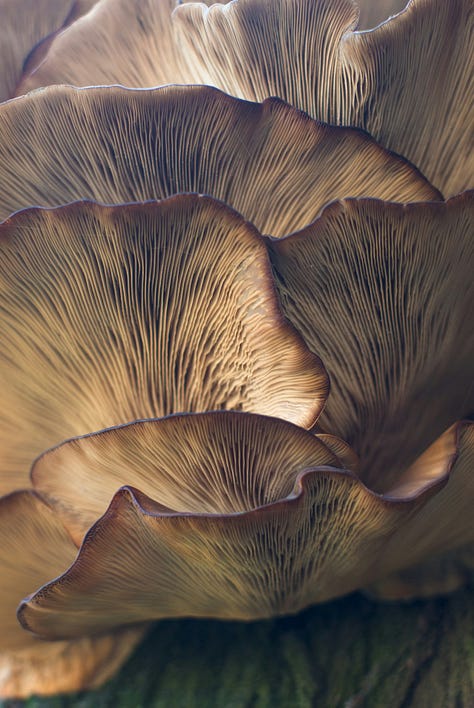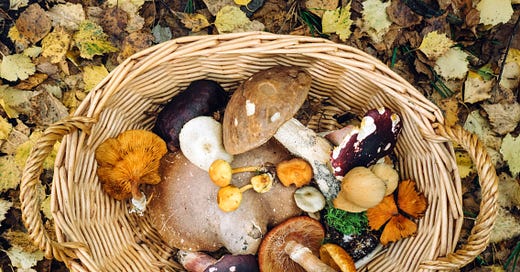The Quiet Disappearance of the Mushroom Hunter’s Season
The Vanishing Harvest Beneath Our Feet
This piece didn’t find a home last year, so I’m giving it one hereThe forest floor, once a theatre for hidden life and ancient rituals, now grows quiet. The rain has been hesitant this year, the earth’s breath shallower. Fewer chanterelles peek out from the leaf litter, fewer porcini heads bob like shipwrecked treasures among the roots. For those who walk with eyes downcast, and fingers keen, mushroom hunting has long been a secret communion - an invitation to read the earth's whispers. But now, the mushroom hunter’s season is vanishing, buried beneath the weight of our warming world.
The art of foraging has always been a delicate negotiation between what the earth offers and what we take. But climate change is changing the terms, shifting the seasons like loose sands.
As temperatures rise and weather patterns become erratic, the conditions for many wild mushrooms - cool, moist soil and steady rainfall - are slipping out of balance. Entire fungal networks, intricate as lace and just as fragile, are retreating deeper into the dark, where droughts and heat cannot touch them.
There was a time when Autumn was predictable, its chill sharpening the air and sending a signal through the understory. Now, late summer stretches its limbs longer, and the rains come either too soon or not at all. What used to be a reliable harvest has become a guessing game. Even veteran foragers find themselves bewildered, returning home empty-handed, the baskets they carry as hollow as the stories of the forest’s decline.
We’ve lost the rhythms, reflect veteran foragers as they witness the unsettling changes in mushroom fruiting patterns. "Mushrooms provide forests with a nervous system, an immune system, and an underground communications network" says Mycologist Paul Stamets, who is an advocate of medicinal fungi and mycoremediation. These fungi play an essential role in maintaining forest health, but climate change and habitat loss are pushing some species, like the Agarikon, to the brink of extinction. As the rains increase in unpredictability, and warm spells stretch on, mushrooms that once appeared like clockwork now seem to hesitate, as if the forest is unsure whether to open its arms or keep everything tucked away. The unstable shifts threaten not just foraging traditions, but the ecological balance of entire woodland systems.



This confusion extends beyond the visible harvest. The underground mycelium - the unseen threads from which mushrooms sprout - plays a crucial role in the health of forests, binding trees together in a web of nutrient exchange and communication. When the forest suffers, so does this hidden world. The loss of certain mushrooms is not just a culinary inconvenience; it’s an ecological warning. When fungi fail to fruit, it signals deeper disruptions in soil health and forest dynamics, which could have cascading effects on biodiversity.
In the misty woods of the Pacific Northwest, where Matsutake mushrooms once scented the air with their spicy, intoxicating aroma, pickers are finding fewer and fewer specimens. Matsutake thrive in conditions of precise moisture and temperature; climate change, with its cruel unpredictability, disrupts this delicate equation. Fewer Matsutake means fewer opportunities for indigenous harvesters whose seasonal work honours centuries-old traditions. It’s not just fungi that are disappearing - it’s culture, sustenance, and history being severed like a mushroom stem from its mycelial roots.
Foraging is more than a culinary pursuit or a weekend pastime. It is a language of intimacy with the earth, a way to learn the topography of seasons, to measure time not by clocks and calendars, but by the gentle swell of mushroom caps. There is poetry in this, a quiet reverence. But how do we preserve something that lives only in the brief flash of its appearance, a glimmering ephemerality we can no longer predict.
The effects are not uniform. In some regions, certain species may appear to thrive with warmer temperatures, but the sudden abundance can be deceptive. As one species finds conditions temporarily favourable, others are lost, unable to adapt. The increased variability turns ancient ecosystems into battlegrounds, where the delicate balance between species tilts precariously. What blooms in abundance today may be gone tomorrow, replaced by an absence too profound for any future harvest to fill.
If the decline of mushroom foraging teaches us anything, it’s that climate change’s touch is intimate. It slips into the most hidden corners, unsettling even the quiet lives that most of us never notice. It reaches into the heart of the woods, brushing against the gills of a mushroom with the same indifference with which it melts glaciers or scorches fields. It is not loud; it does not shout. It simply unsettles, shifting the pulse of the world and leaving us, baskets in hand, wondering where the bounty has gone.
The loss of foraging’s magic cannot be measured in GDP or carbon emissions. It is counted in the stories that will not be passed down, in the hours spent wandering with no prize at the end, and in the grief of those who have come to know the forest like an old friend, only to find that friend slipping away. We may not yet know the full price of this quiet disappearance, but we feel it in the stillness - an absence spreading, like mycelium, through the very soil beneath our feet.
In the end, perhaps the most pressing question is not how we will adapt, but whether we can restore the earth’s rhythms, or if we must now learn to dance to a tune that is forever changing, as the mushrooms once again recede into the shadowed places where only the earth remembers.
Thank you for reading Threads of Thought. This work is a labour of love, offered freely to all. If you feel you learnt something or feel moved to support my creative journey, you can donate below. Your support for my craft is deeply appreciated.






so beautiful Yalda
Lovely